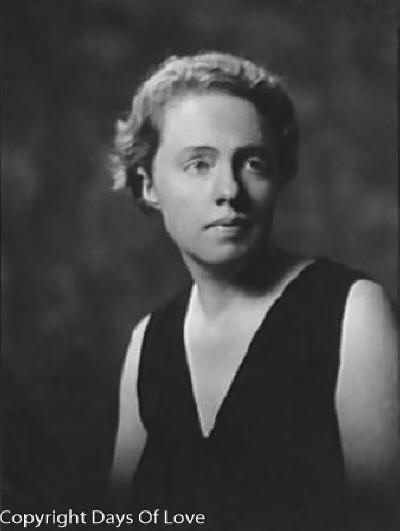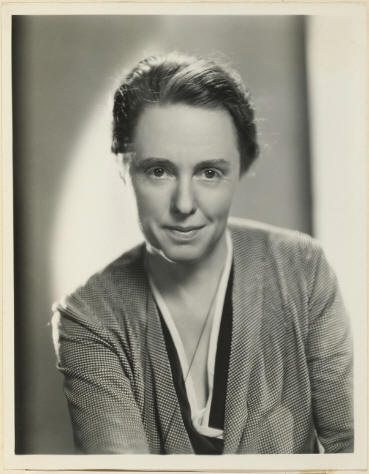BURIED TOGETHER
Partner Rachel Barrett,
Sara Josephine Baker,
Louise Pearce, buried together with Pearce
Queer Places:
Trevenna Farm, 208 Orchard Rd, Skillman, NJ 08558, Stati Uniti
 Ida
Alexa Ross Wylie (16 March 1885 – 4 November 1959), known by her pen name
I. A. R. Wylie, was an Australian-British-American novelist, screenwriter,
short story writer, and poet who was honored by the journalistic and
literary establishments of her time, and was known around the world.
She was a member of the Heterodoxy Club.
Ida
Alexa Ross Wylie (16 March 1885 – 4 November 1959), known by her pen name
I. A. R. Wylie, was an Australian-British-American novelist, screenwriter,
short story writer, and poet who was honored by the journalistic and
literary establishments of her time, and was known around the world.
She was a member of the Heterodoxy Club.
Between 1915 and 1953, more than thirty of Wylie's novels and stories were
adapted into films, including Keeper of the Flame (1942), which was
directed by George
Cukor and starred Spencer Tracy and
Katharine
Hepburn.
Wylie was born Ida Alexa Ross Wylie on 16 March 1885 in Melbourne,
Australia to Alexander Coghill Wylie from England and Ida Ross, a farmer's
daughter from Australia.[1][2]
I. A. R. Wylie's father, Alec Wylie of England, was in debt much of his
life and often on the move from creditors.[2]
And so it was that sometime in the 1880s he fled England for Australia,
but not before divorcing his first wife while proposing to her sister,
Christine (who refused).[2]
In Australia, he soon married a plain farmer's daughter named Ida Ross.[2]
The couple's first child, I. A. R. Wylie, was born in Melbourne, Australia
in 1885, literally named after her parents: Ida Ross and Alec Wylie.[2]
In 1888, Alec moved back to London with his new wife and young child, but
Ida Ross died shortly thereafter.[2]
Alec then renewed relations with Christine, his first wife's sister, and
Christine became the young Wylie's home school teacher and guardian,
raising her while her father struggled from one crisis to the next.
"Christine was just the first of a line of women who proved far stronger
and more reliable than any man in Ida's life."[2]
After spending three years in finishing school in Belgium, Wylie first
studied in England, and later in Germany, where she also taught and began
writing.[1]
Wylie's self-education at home meant she spent many hours making up her
own stories to fill up time, and, at the age of 19, she sold her first
short story to a magazine.[2]
For example, Wylie had a roommate named Esme who had been raised in India
and so she wrote stories based on Esme's reminisces.[2]
Wylie went on to write at least five books based in India, The Native
Born, or, The Rajah's People (1910); The Daughter of Brahma
(1913); Tristram Sahib (1915); The Temple of Dawn (1915);
and The Hermit Doctor of Gaya (1916). While living in Germany in
the early 1910s, she wrote a number of books including My German Year
(1910); Rambles in the Black Forest (1911); The Germans
(1911); and Eight Years in Germany (1914).[2]
Her novel, Towards Morning (1918), was "perhaps the first in
English to suggest that not all Germans were evil imperialists."[2]

by Arnold Genthe

.JPG)
Trevenna Farm, Skillman
In 1911, Wylie returned to England, living in St John's Wood, London[3],
and joined the Suffragette movement.[2]
She provided a safe house for women who were released from prison where
they could recover from hunger strikes under the "Cat and Mouse Act"
without being watched by the police.[2][3]
She struck up a relationship with the editor of "The Suffragette",
Rachel Barrett, and by mid
1913 was a useful "sub-editor and bottle-washer". She travelled with
Annie Kenney,
Jessie Kenney and
Mary Richardson to spend a week in France with
Christabel Pankhurst[3].
Wylie and Barrett then travelled to Edinburgh to Wylie's aunt Jane, where
Barrett had surgery and lived under a pseudonym to avoid re-arrest. Both
returned to London for Christmas 1913, and continued to secretly edit
The Suffragette until May 1914, when police again raided the premises
in Lincoln's Inn.[3]
In 1917, Barrett and Wylie traveled to America. They bought a car and
roamed around the country, from New York to San Francisco, a remarkable
journey with the state of roads and cars at the time.[2]
Wylie eventually settled in Hollywood where she sold her stories.[2]
Over thirty movies were made between 1915 and 1953 based on her works,
including Torch Song (1953) and Phone Call from a Stranger
(1952).[3]
Her story, "Grandmother Bernle Learns Her Letters", published in the
Saturday Evening Post in 1926, was filmed twice—by John Ford in 1928
as Four Sons, and by Archie Mayo in 1940, also as Four Sons.[2]
She is probably best known as the author of the novel that became the
basis of the film Keeper of the Flame (1942), directed by
George Cukor and
starring Spencer Tracy and
Katharine
Hepburn.[2]
"Neither Baker nor Wylie ever declared themselves openly as lesbians,
but according to Dr. Bert Hansen’s article, "Public Careers and Private
Sexuality: Some Gay and Lesbian Lives in the History of Medicine and
Public Health", the Wylie and
Sara Josephine Baker were partners."[2][4]
Other authors have identified her as a lesbian including Laura Doan in
Fashioning Sapphism: The Origins of a Modern English Lesbian Culture,[5]
Anne McMay in Wolf Girls at Vassar: Lesbian and Gay Experiences
1930-1990[6]
and Lesbian lives: Biographies of Women from the Ladder.[7]
In her autobiography My Life with George, in which the "George"
of the title is her subconscious ego, Wylie says:
- "I have always liked women better than men. I am more at ease with
them and more amused by them. I too am rather bored by a conventional
relationship which seems to involve either my playing up to someone or
playing down to someone. Here and there and especially in my latter
years when there should be no further danger of my trying to ensnare
one of them I have established some real friendships with men in which
we meet and like each other on equal terms as human beings. But
fortunately, I have never wanted to marry any of them, nor with the
exception of that one misguided German Grenadier, have any of them
wanted to marry me."[8]
In her autobiography she acknowledges that many of her women friends
refer to her as "Uncle," and as one critic says, her choice of being
credited as "I. A. R. Wylie" instead of Ida Wylie was certainly an attempt
to downplay her gender in publications.[2][8][4]
In the 1930s, Wylie, Sara Josephine Baker and another pioneering woman
physician, Dr. Louise
Pearce, settled on a property near Skillman, New Jersey called
Trevenna Farm.[2]
They lived there together until Baker died in 1945, followed by Pearce,
and then later Wylie who died on 4 November 1959 at the age of 74. Wylie
and Pearce are buried alongside each other at Henry Skillman Burying
Ground, Trevenna Farm's family cemetery.[2]
My published books:


BACK TO HOME PAGE

- https://en.wikipedia.org/wiki/I._A._R._Wylie
 Ida
Alexa Ross Wylie (16 March 1885 – 4 November 1959), known by her pen name
I. A. R. Wylie, was an Australian-British-American novelist, screenwriter,
short story writer, and poet who was honored by the journalistic and
literary establishments of her time, and was known around the world.
She was a member of the Heterodoxy Club.
Ida
Alexa Ross Wylie (16 March 1885 – 4 November 1959), known by her pen name
I. A. R. Wylie, was an Australian-British-American novelist, screenwriter,
short story writer, and poet who was honored by the journalistic and
literary establishments of her time, and was known around the world.
She was a member of the Heterodoxy Club.
.JPG)

